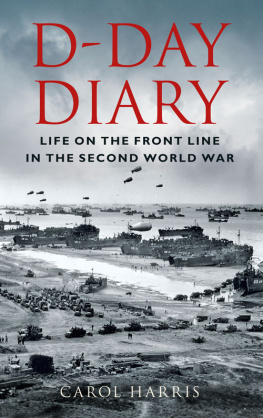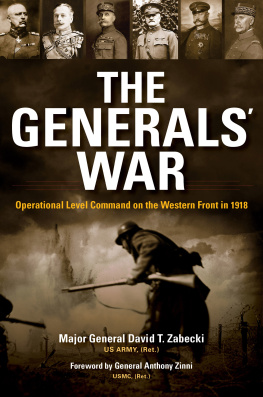AN AMERICAN SOLDIER IN THE GREAT WAR
The World War I Diary and Letters of Elmer O. Smith
2015 John DellaGiustina
Published by Hellgate Press
(An imprint of L&R Publishing, LLC)
All rights reserved. No part of this publication may be reproduced or used in any form or by any means, graphic, electronic or mechanical, including photocopying, recording, taping, or information and retrieval systems without written permission of the publisher.
Hellgate Press
PO Box 3531
Ashland, OR 97520
email: sales@hellgatepress.com
Editor: Harley B. Patrick
Interior design: Michael Campbell
Cover design: L. Redding
Cover photo: The formal military portrait of Private Elmer O. Smith in uniform was likely taken in June 1917. It appeared in the post-war book of photographs of servicemen from the Lansing, Michigan area, entitled, Honor Roll and Complete War History of Ingham County in the Great World War, 1914-1918.
Library of Congress Cataloging-in-Publication Data
Smith, Elmer O., 1897-1968.
An American soldier in the Great War : the World War I diary and letters of Elmer O. Smith : Private First Class, 119th Field Artillery Regiment, 32nd Division / edited by John DellaGiustina. -- First edition.
pages cm
Includes bibliographical references.
ISBN 978-1555718220
1. Smith, Elmer O., 1897-1968--Diaries. 2. World War, 1914-1918--Personal narratives, American. 3. World War, 1914-1918--Campaigns--Western Front. 4. United States. Army. Field Artillery, 119th. 5. United States. Army. American Expeditionary Forces--Biography. 6. Soldiers--United States--Diaries. 7. Lansing (Mich.)--Biography. I. DellaGiustina, John, editor. II. Title. III. Title: World War I diary and letters of Elmer O. Smith.
D570.9.S553 2015
940.41273092--dc23
[B]
2015018538
To my Mother Sharon, Aunt Margo, and Uncle Steve, children of Elmer and Marjorie Smith and their families
It s whats left that matters.
Photographs, letters, empty clothes,
no, its the stories behind them,
those are what matter.
Stories live forever,
but only if you tell them
From the 2012 movie Memorial Day
Preface
In August 2014, the world remembered the 100th anniversary of the start of one of the most ghastly conflicts in human historythe Great War, the War to End All Wars, and commonly referred to in recent times as World War I or the First World War. In 1917, the United States joined the Allied effort to defeat Germany, culminating with victory in November 1918.
Over the past decade the last survivors who fought in this major war have passed from this earth. Now the only sources of information from this conflict are the written records. These include the numerous personal accounts, unit files, newspaper articles, journals, and books that have documented the carnage and events of that now distant past. This book centers on one soldiers actions in that conflict and adds to the existing record of primary source material.
Elmer O. Smith was my grandfather. Enlisting in the U.S. Army in April 1917, he started a diary on New Years Day 1918. Throughout that pivotal year he made short entries into this diary to document his activities and thoughts. These entries captured what he faced in his units training, their deployment overseas to France, battles with the German Army, his wounding, subsequent convalescence, return to the front lines and the armistice. It describes the rigorous day to day activities of a soldier training for and facing combat during World War I.
The unpublished diarys entries are supplemented throughout the book by many of the letters he wrote to his mother, Olive Smith and sister, Zelma Smith. The diary and letters were transcribed from the existing documents and incorporated in their original form, misspellings, punctuation errors, and all. Multiple primary and secondary sources have contributed to a more complete war record of this soldier and framed his war life within its historical context. As a soldier at the bottom of his chain of command, Private Smith did not have the luxury of the wider perspective that these additional sources can now provide. Thus, this book aims to show how Private Smith was just one part of a much larger, broader effort to bring American combat power to bear on the German Army and bring about the end of four years of devastating conflict in Europe and elsewhere.
I personally thank and acknowledge the extensive efforts over the years of my Aunt Margo to preserve the Smith family history, to include the transcribing of her fathers handwritten diary and letters. As a trained historian and career U.S. Army officer, I accept responsibility for any errors or omissions contained in this book.
Tucson, Arizona
April, 2015
Chronology
World War I Timeline
of Elmer O. Smith
April 6, 1917: The United States declares war on Germany
April 30, 1917: Elmer O. Smith enlists in Battery B, First Michigan Field Artillery Battalion, Michigan National Guard, Lansing; Begins twice-a-week training, initially at Lansing Armory, then Camp Hoague in east Lansing
May/June, 1917: U.S. Draft established
July 3, 1917: Proclamation of President Wilson federalizes the National Guard units of Michigan, Wisconsin, and most other states
August 3, 1917: 32nd Division established and organized. Michigan National Guard units incorporated. Battery B becomes part of 119th Field Artillery (FA) Regiment, 57th FA Brigade, 32nd Division
August 5, 1917: All National Guard soldiers formally drafted into Regular Army
August 17, 1917: Battery B moves via train to mobilization site, Camp Grayling, Michigan
October 1, 1917: 119th FA Regiment moves via train to Camp MacArthur, Waco, Texas
January 1, 1918: Private Elmer Smith starts 1918 Diary
January 4, 1918: Private Smith transferred to Headquarters Company, 119th FA Regiment
February 6, 1918: 119th FA departs Camp MacArthur via train for New York City vicinity
February 11, 1918: 119th FA arrives at Camp Merritt, Tenafly, New Jersey
February 26, 1918 : 119th FA departs New York harbor on British transport ship Olympic bound for Great Britain
March 6, 1918: 119th FA unloads ship in Liverpool, England
March 10, 1918: 119th FA crosses English Channel on ferry from Southhampton, England; arrives in Havre, France the next day
March 13, 1918: 119th FA arrives at Camp Coetquidan, France, artillery training post, via train
June 4, 1918: 119th FA departs Camp Coetquidan by train for the Western Front
June 7, 1918: 119th FA arrives Toul, France. Moves to French village 12 miles behind front lines
June 13, 1918: 119th FA moves to French village six miles behind lines
June 14, 1918: 119th FA moves to firing positions
June 16, 1918: Private Elmer Smith wounded in action in enemy artillery attack on position at approximately 3:30 PM. Evacuated to front line hospital
July 11, 1918: Private Smith departs hospital in vicinity of Toul; travels by train to hospital at Basiolles
July 16, 1918: Private Smith travels to convalescent camp 3 miles from Basiolles hospital
July 22, 1918: Private Smith declared fit for service; leaves convalescent camp, travels to Neuf Chateau and Chaumont via train; arrives St. Aignan the next day
July 29, 1918: Private Smith leaves St. Aignan for replacement camp via Tours and Bordeaux; arrives at Camp Corneau near Atlantic Ocean the next day
August 7, 1918: Private Smith departs Le Corneau replacement camp by train; travels via La Teste, Bordeaux, Tours, Orleans, Nancy Le Sec, Chateau Thierry
August 9, 1918: Private Smith arrives at 32nd Division Headquarters, Mezy













